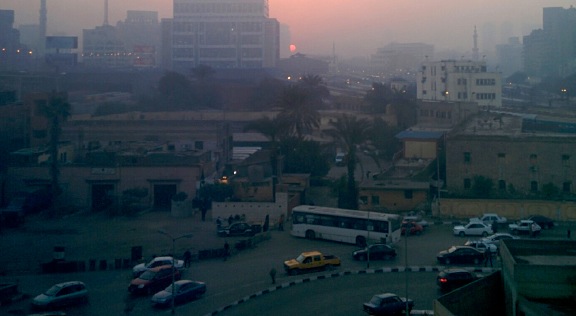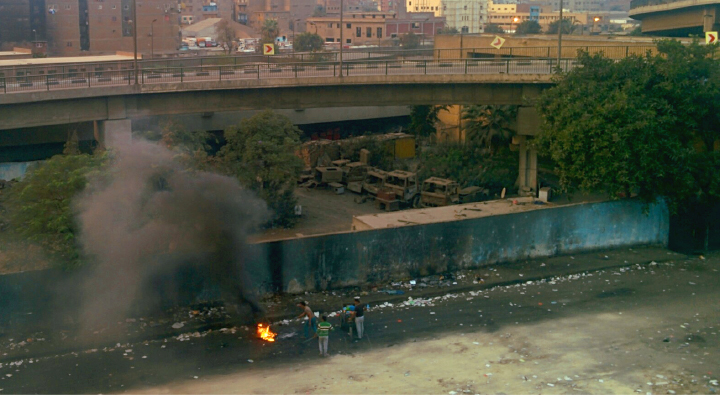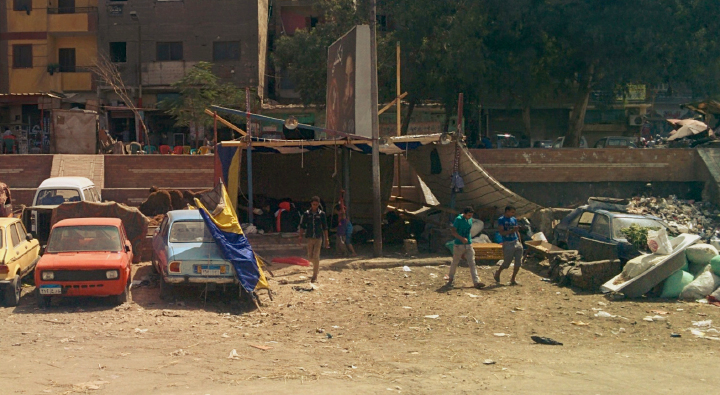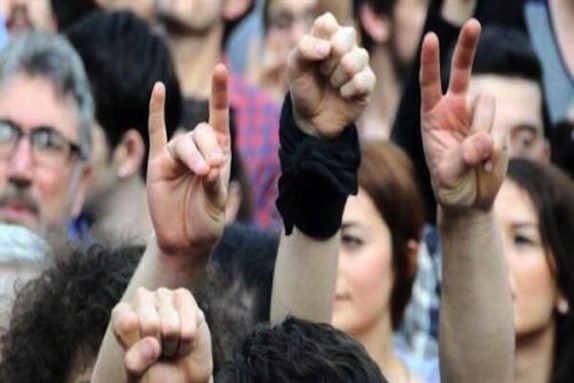Cairo, Winter 2015
The feelings of claustrophobia, exhaustion, and asphyxia are familiar to all of those who inhabit Cairo`s kinetic and crowded urban core. Everyone living between Tahrir and the plateaus of Muqattam breathes the same polluted air that chokes much of the city, saturated with particulates from leaded car exhaust, factory emissions, scorched crop leftovers, and burning garbage dumps. It is within these atmospheric conditions that people are born and live their lives, always-already arriving in the middle of and inheriting complex and overlapping global pasts with each breath.
Following Abdel Fattah al-Sisi`s rise to power during the summer of 2013 in a highly dramatic military coup, a dark affect has also come to saturate the air of the Nile valley. Many of the democratic and material gains of the Egyptian revolution seem to have dissolved with the return of military rule, and new emergency anti-protest laws have sent hundreds of revolutionaries to prison for years simply for attending demonstrations. It is tempting at times to feel that everything that had become possible in Egypt during the eighteen revolutionary days of 2011 has now been completely curtailed by the security state, leaving little room to breathe anything other than the stale exhaust of smoldering dreams. Blogger Sarah Carr has poignantly described these years as “that time we jumped off a cliff reaching for the moon” while asking “whether it was worth it, whether those lives shattered and destroyed have laid the groundwork for something or are just gone.”

[Sunset in the Black Cloud, Cairo, 2014 (Photo: Ian Paul)]
And yet those living within the black cloud of Cairo overflow with collective forms of activity that seemingly shake off many of the harsh realities of the city, thoroughly entangled with one another in thousands of tiny gestures of solidarity that largely escape notice. In downtown`s outdoor cafes where groups gather in the mornings and evenings to drink coffee and tea or smoke shisha, reading the daily newspapers or watching football matches, people relax together and sustain informal spaces of sociality. In the vast networks of baking and delivering inexpensive bread, recycling every form of trash, and building cheap brick housing complexes in Cairo`s ashwa`iyyat, the city`s poor find a way of sheltering and sustaining one another`s lives, however precarious. And occasionally, in the streets surrounding Tahrir Square, in the chaotic accumulation of demonstrations, occupations, and riots of the past years, people have found ways of building fragile yet tangible imaginations and futures with one another. Each of these tiny acts are part of much more prolonged and expansive forms of solidarity and care that people lend each other over spans of years or even entire lives, an aggregate that not only preserves life but also preserves the conditions that make life possible.
These gestures of solidarity are framed by the histories that they arise from, as well as by the futures they call into being. Each act is figured by, as well as prefigurative of, complex economic relations, urban transformations, social controls, and transnational as well as local migrations and settlements, all unfolding in the context of Egyptian neoliberalism. As Salwa Ismail notes in her book Political Life in Cairo`s New Quarters: “Part and parcel of the political economy transformations is a remapping of the city whereby new lines of division and fragmentation of the urban fabric have emerged.” Therefore “we should direct our attention to the actual living conditions in the quarters, to the efforts undertaken by the residents to change these conditions and fashion modes of living in the face of grinding political and economic constraints.” It is here, in the manifold practices that “fashion modes of living”, that we can glimpse how heterogeneous and unresolved economic, social, and political pasts are enmeshed with the plural futures of the city`s diverse inhabitants, each vibrantly modulating the conditions oh possibility and impossibility for various forms of life.
I now think that many of us have too often thought of revolution only as a kind of rupture, an intense and radical departure away from the old and towards the new. Even the given name of the “Arab Spring” has framed the revolt in Egypt as a passing season, already historically contained. From this perspective every revolution is an already-failed revolution, always stopping short of completely undoing past injustice. Instead, I wonder what it would mean to think of revolution in terms of its continuity rather than its potential to break away, pushing our attention towards the importance of duration and patience with the same gravity that has otherwise been given to dramatic street battles and demonstrations. How can we come to think of revolt as an exercise of perseverance and stamina, a collective technique of producing futures through durational practices in the present? What could we say constitutes the revolutionary practice of endurance?
Endurance of Different Kinds
Ever since the military formally returned to power in July 2013, Egyptian police, soldiers, and state-organized thugs have attacked demonstrations incessantly. Those who are lucky have managed to slip away from these attacks with only the sharp burning of tear gas in their lungs, either escaping into an open restaurant, quickly catching one of Cairo`s many taxis, or disappearing into the bustle of a nearby metro station, all while evading the plethora of plainclothes police that roam the area before, during, and after demonstrations. Others are beaten in the streets or in the back of police trucks, detained and sentenced to years in jail, tortured at police stations, or killed. The protests that have repeatedly filled the streets in this context have done so under threat of extinction, as the military regime has not only consistently dispersed protests when they appear but has also attempted to strangle the very conditions and relations from within which resistance is possible.
One of the means the military regime has used to forcefully establish its power in Egypt is the assault on communities that have practiced informal forms of refuge and care. The state`s systematic attacks on homosexuals, political dissidents, students, artists, and women are each meant to suffocate instances of being-together that have the potential to reorganize the forms and practices of endurance that do not rely upon the state. In place of these precarious refuges, the regime has implemented spaces of security that are solely meant to be defended by the military against a diversity of persistent existential threats, either described as “terrorism,” “foreign influence,” or “indecency.” This has led to policies such as the de facto ban of nongovernmental organizations that receive any kind of funding from outside the country, the proliferation of security checkpoints in universities and on roads, as well as the destruction of entire neighborhoods in the Gaza border region. The military regime organizes to ensure that the possibility of everyone`s survival wholly relies upon a military-imposed security, and in turn extinguishes the conditions of possibility for varied forms of survival and endurance that differentially manifest.

[Youth Burning Garbage, Cairo, 2014 (Photo: Ian Paul)]
This “differential endurance,” the survival and duration of a different kind of life in Egypt, is something that has persisted despite the deep intensities of state repression. Organizing to produce different environments and relationships within which to endure has manifested as a form of resistance against a military that means to totalize its control over the practice of survival itself. Endurance is revolutionary in this context not only in the ways that individuals come to survive the violence of the state, but importantly in the encounters, exchanges and proximities that necessarily arise from the practices of endurance that produce new conditions of possibility for living, surviving, and revolting. This configuration of endurance-as-resistance both precedes the power of the state and exceeds the state`s organization, moving us to consider not only the way new practices of living become possible within the fleeting revolutionary periods of turbulent riots and street battles, but also within the prolonged revolutionary forms of survival that erode the logic of security.
Asef Bayat has described these practices of endurance as “the quiet encroachment of the ordinary”, illustrating how vast informal economies and decentralized forms of autonomous organization among the poor manifest as potent political and historical forces in relation to more widely recognized forms of power. What this description does not emphasize, however, is the way in which all of politics hinge on various forms of duration; just as the informal communities in Cairo`s slums struggle to endure, so too does the state engage in “quiet” and “ordinary” practices that produce its duration. The important distinction is in locating how these encroachments aggregate and disaggregate sets of relations that allow for or disallow assorted practices, differentially supporting the duration of some bodies, things, and environments over others.
The repeated military closure of Tahrir Square has perhaps been the most obvious manifestation of the military regime`s attempt to impose totalizing spaces of security in Egypt in the interest of its own survival. In the past weeks, any sign of possible unrest has led to widespread military mobilizations that have included the complete closure of Tahrir on all sides, attempting to dissolve any potential for a revival of the intensity of the eighteen days of revolt in 2011. The closures of Tahrir take place in a downtown that has also been shaped by a pervasive military presence, with armored personnel carriers regularly stationed around government buildings, accompanied by young conscripts with automatic rifles that are often too big for their small frames. These military strategies have, over time and through their repetition, taken on their own “ordinariness” and have set into motion the duration of a militarized Cairo.

[The Ashwa`iyyat (the “randoms”), Cairo, 2014 (Photo: Ian Paul)]
Following the Muslim Brotherhood`s weeks-long occupation of Rabaa al-Adawiya Square in defiance of al-Sisi`s coup, and its end in a massacre of more than one thousand protesters in August of 2013, many groups have refused to share the streets of Cairo together in any meaningful way. Mutual perceptions of betrayals and failures persist, despite a shared opposition to the military`s seizure of state power. However, recent protests against Hosni Mubarak`s acquittal on charges related to the killing of protesters have been composed of more diverse aggregates of groups that have gone against these sectarian trends. In the largest of the demonstrations against Mubarak`s acquittal, the chants from the revolution found new voice in the crowds, and a mixture of students, ultras, revolutionaries, journalists, and Islamists appeared together in the streets for the first time in many months. The appearance and accumulation of crowds such as these is felt as a threat to the military order. It suggests the possibility that strangers might find one another across fields of political and social difference, united by a shared precarity and vulnerability to violence.
The Transversality of Alliance
The act of appearing in alliance together in the streets threatens to make porous the boundaries that both separate and tie together, reorganizing the limits of the social and potentially engendering new practices and relations of survival and endurance. As much as the political divides in Egypt seem to foreclose the potential for new coalitions and alliances, what must be stressed is that one`s positionality is never entirely resolved nor fixed, but rather is incessantly reproduced in the encounters that occur when people appear together and to one another in shared spaces. As Judith Butler has argued: “The body is constituted through perspectives it cannot inhabit; someone else sees our face in a way that none of us can. We are in this way, even as located, always elsewhere, constituted in a sociality that exceeds us.” To congregate in this way is to be with, think with, act with, appear with, and endure with people that are ineradicably different from one another, and to engage in collective forms of transformation and endurance that cannot be fully anticipated in advance.
When people protest together, as they have against Mubarak`s acquittal, or when they mourn together, as they recently have on the third anniversary of the Maspero massacre, they enter into situations that have unpredictable outcomes by virtue of the diverse individuals involved, introducing noise into an otherwise calm present and creating turbulence where unpredicted futures filled with novel relations can take hold; this noise is what makes resistance possible. The scattered and transversal movements that occur in the noisy aggregation and disaggregation of alliances produce plural futures that dislocate otherwise regulated social and political arrangements.
A necessary component of any revolutionary project is a radical re-evaluation not only of the order and hierarchy of individual parts of a society, but also of what fundamental ethical responsibilities exist or could exist between those parts. To understand endurance as a practice of resistance is to grasp how survival is always framed by an uncompromising fragility, vulnerability, and interdependency that shapes all of life in disproportionate ways. These fragilities, vulnerabilities and interdependencies become the foundation for ethical and political projects only when it is acknowledged that people come to survive differently, and that established formations of power differentially privilege the survival of some over others. The diversity of revolts and occupations that have taken place in Egypt since 2011 manifest as the resistance of the endurant precisely when they are translated and persist beyond the moments of intensity themselves into more prolonged, nuanced, and complex forms of caring relation that threaten to reorganize these formations of power.
.jpg)
[Summer`s Shade, Cairo, 2014 (Photo: Ian Paul)]
The practice of endurance is revolutionary in this sense not only in the care for oneself or for those who are already proximate under the duress of state violence, but also in the production and preservation of conditions within which new forms of proximity and care can take shape, and within which the survival of lives of variously distant and different others can be sustained more generally. Along these lines, the protests that have taken place across Egypt since the revolution are situated in much more diffuse currents of collective activities, everyday practices, and infinitely subtle forms of support. These act against the contingency not only of the participants but of the larger contexts within which all of life is lived. In the process of appearing and circulating together, a transversal play between proximity and distance takes place that provides new opportunities for alliance and care that do not conform to the present formations of power.
After several hours, only a few hundred meters away from a blocked-off Tahrir Square, the diverse groups that had congregated in Abdel Moneim Riad Square in response to Mubarak`s acquittal were rapidly attacked and dispersed by the military and police. People fled onto various side streets in the hopes of escaping arrest; only some of them were successful. Police vehicles chased running protesters around downtown for hours, ambushes were set up and people were dragged out of cars with guns pointed at their heads. Plainclothes police hunted for those trying to escape unnoticed, desperately concealing any appearance of injury or trauma that they had just experienced that would link them to the gathering. In the end, two protesters were killed, nine were injured, and eighty-four were arrested. While not forgetting the violent reality of the state`s repression, it is also important to insist here that even though the military was able to disperse the gathering, the relations that drew people together and that people carried away with them are not so easily suffocated. These relations suggest a continuity of the revolution that will continue to transform Egypt in the various forms they adopt, producing new conditions and situations that the military cannot wholly smother.
One of the most striking and visible changes following Mohamed Morsi`s ouster and al-Sisi`s ascent was a repainting of many of downtown Cairo`s facades, as well as the planting of a manicured lawn and installation of a military memorial in Tahrir Square. Large sections of Mohamed Mahmoud Street, the site of some of the largest clashes between police and demonstrators in 2011, and famous for its elaborate murals memorializing the revolution’s martyrs, have been repeatedly painted over as well. In the end, such cosmetic projects do little to bury pasts that are not yet passed, but still thickly infuse the air of the city; activist artists have consistently covered Mohamed Mahmoud Street with new murals every time it has been painted over, and the military has just recently removed its own memorial from Tahrir in anticipation of the protests that will accompany the fourth anniversary of the revolution. After the street battles, in the brief pauses between the gasps of air from those who have just escaped the police`s clubs, tear gas, and bullets, dynamic forms of care allow for new durations to emerge that remake the world itself. These diverse forms of endurance are ultimately incongruent with the military`s secure present and suggest the potential for differential practices of living to emerge. The revolution persists on the streets of Egypt in the lives of the endurant who, with each breath, carry the unfinished relations of the revolution forward.
Postscript
On 24 January, the eve of the fourth anniversary of the revolution, the socialist activist Shaimaa al-Sabbagh was shot and killed by police in downtown Cairo. She was part of a small demonstration that was headed to Tahrir Square to lay a wreath of flowers in honor of the martyrs of the revolution when security forces fired the birdshot that took her life.
This short reflection was meant to help us think about the endurant, but I hope that it also speaks more broadly to the struggle to cultivate the fragile and shared conditions within which we all are born and will eventually die. Those that have collapsed in the fight for not only the possibility of survival, but also for qualitatively better lives, do not so simply disintegrate and vanish when their breath stops. Rather, their actions and gestures will continue reverberate through the futures that they helped call into being.
This text is dedicated to her life, and to all of the ways her life will continue to find expression in futures and lives that are still in the process of becoming.
![[Sunset in the Black Cloud, Cairo, 2014 (Photo: Ian Paul)]](https://kms.jadaliyya.com/Images/357x383xo/Ian_Paul1.jpg)















